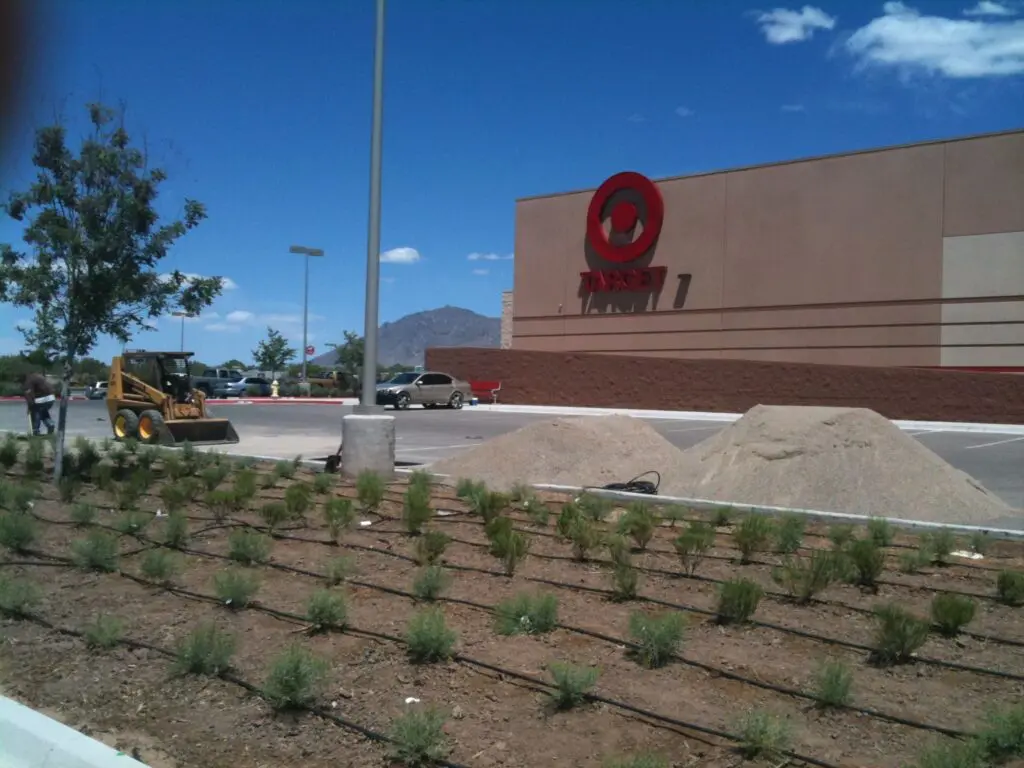Albuquerque Drip Irrigation Strategies
Both homeowners and landscaping companies use drip irrigation systems in Albuquerque. You can find drip irrigation systems in Albuquerque home landscaping and Albuquerque commercial landscaping.
When you start putting in a drip irrigation system at your Albuquerque house, let the drip irrigation tubing for your system lie out in the sun for a little while to warm it up. Once the tubing is warmed up it will be easier to work with when laying it out throughout your landscaping.
If you decide to take any drip water emitters out of your drip irrigation tubing system once you have it set up, you can cover up the holes with a small plastic plug, or “goof plugs,”. A goof plug will block water at that access point, but the water will continue to flow through to the rest of the drip irrigation system.
Drip Irrigation Water Saving Strategies
Planting near a low hedge or other type of barrier will cut wind, which cuts evaporation and, ultimately, watering less often.
Be careful not to overwater. For outdoor plants with moderate water needs, the amount of water required can vary based on factors such as climate, soil type, and plant size. However, the general guidelines are:
- Small plants (flowers, small shrubs): 1-2 gallons per week
- Medium plants (larger shrubs, small trees): 5-10 gallons per week
- Large plants (mature trees, large shrubs): 10-20 gallons per week
Additional Tips:
- Deep Watering: Water deeply encourages deeper root growth. This helps plants become more drought resistant.
- Timing: Water early in the morning or late in the afternoon to minimize evaporation.
- Soil Check: Ensure the top 1-2 inches of soil are dry before watering again.
- Mulching: Applying mulch around the base of plants helps retain soil moisture and reduces watering frequency.
Adjust the amount of water flowing through the drip system based on rainfall, as outdoor plants may require less water during rainy weeks.
Using a one gph emitter, this will drop in about an hour if this machine is running. There should not be any water puddling area near the emitters. In warmer climates, 2” of rainfall per week is typically needed. Watering thoroughly but infrequently is best.
How To Know If Your Drip Irrigation System is in Good Shape
To test your drip irrigation system, stick a pencil or pointed stick into the ground halfway between the emitters to see if water is seeping. And during rain, the pencil/stick will effortlessly penetrate the dirt. It is easy to add or move emitters as needed.
Above ground drip irrigation systems are less prone to clogging than are in ground systems, and are easy to relocate while gardening. Covering the ground with a layer of mulch both conceals the irrigation tubes and reduces evaporation.
That way, for a buried system you’ll want to lay out a plan before you start digging trenches. Once you have your tubing in place, do not cover the trenches, and test the system.
What About Colder Climates?
In colder climates, drip irrigation systems must be drained at the end of the growing season. This just means unstopping or uncoffin crimped ends.
This helps to keep it from breaking or cracking in freezing temperatures. Tying a piece of plastic or cloth over the open line ends will prevent any insects and junk from getting into them. In the winter, filters, pressure reducers and timers should be stored indoors.
For raised bed gardens, use “tees” and “elbows” to run lines up and into the raised frame.
To learn more about drip irrigation or to schedule a quote for a drip irrigation system at your home in Albuquerque, reach out to us here at ASAP Sands Outdoor Services., via telephone at 505-293-4014 or complete our CONTACT US form.

